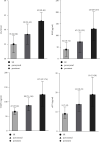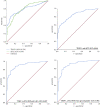Biomarkers for Predicting the Occurrence and Progression of Atrial Fibrillation: Soluble Suppression of Tumorigenicity 2 Protein and Tissue Inhibitor of Matrix Metalloproteinase-1
- PMID: 36683600
- PMCID: PMC9825235
- DOI: 10.1155/2022/6926510
Biomarkers for Predicting the Occurrence and Progression of Atrial Fibrillation: Soluble Suppression of Tumorigenicity 2 Protein and Tissue Inhibitor of Matrix Metalloproteinase-1
Abstract
Background: Soluble suppression of tumorigenicity 2 protein (sST2) and tissue inhibitor of matrix metalloproteinase (TIMP)-1 are involved in multiple pathogenic pathways, including cardiac remodeling, which is the main pathology of atrial fibrillation (AF). This study aims to investigate the previously unexplored relationship between the serum levels of sST2, TIMP-1, and AF.
Methods: This was a prospective cross-sectional study conducted at the Capital Medical University Affiliated Beijing Anzhen Hospital between June 2019 and July 2020, with a total of 359 participants. The clinical characteristics and laboratory results of the patients were compared, and multivariable ordinal logistic regression was used to evaluate the relationship between serum sST2, TIMP-1, and AF.
Results: The participants included 110 patients with sinus rhythm (SR), 113 with paroxysmal AF (the paroxysmal AF group), and 136 with persistent AF (the persistent AF group). It was found that the sST2 levels gradually increased in these three groups, from 9.1 (6.7-12.4 pg/ml) in the SR group to 14.0 (10.4-20.8 pg/ml) in the paroxysmal AF group and to 19.0 (13.1-27.8) pg/ml) in the persistent AF group (p < 0.001). The multivariable ordinal logistic regression model for sST2 and TIMP-1 demonstrated that sST2 had an area under the receiver operating characteristic (ROC) curve (AUC) of 0.797 (95% confidence interval (CI) 0.749-0.846, p < 0.001) and TIMP-1 had an AUC of 0.795 (95% CI 0.750-0.841, p=0.000). The multivariable ordinal logistic regression model for sST2 and TIMP-1 showed good discrimination between SR and AF, with an AUC of 0.846, and the addition of clinical factors, such as brain natriuretic peptide (BNP), left atrial diameter, age, and gender, to the biomarker model improved the detection of SR and AF (AUC 0.901).
Conclusions: In this cohort study, sST2 and TIMP-1 were associated with AF progression, independent of clinical characteristics and biomarkers. Soluble ST2 and TIMP-1 combined with age, elevated N-terminal-pro hormone BNP(NT-BNP), and an enlarged left atrium were able to demonstrate the progression of AF reliably.
Copyright © 2022 Wei-Ping Sun et al.
Conflict of interest statement
The authors declare that they have no conflicts of interest.
Figures




References
-
- Hindricks G., Potpara T., Dagres N., et al. ESC Guidelines for the diagnosis and management of atrial fibrillation developed in collaboration with the European Association for Cardio-Thoracic Surgery (EACTS): the Task Force for the diagnosis and management of atrial fibrillation of the European Society of Cardiology (ESC) Developed with the special contribution of the European Heart Rhythm Association (EHRA) of the ESC. European Heart Journal . 2020;42(5):546–547. doi: 10.1093/eurheartj/ehaa612. - DOI - PubMed
MeSH terms
Substances
LinkOut - more resources
Full Text Sources
Medical
Research Materials
Miscellaneous
